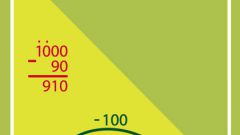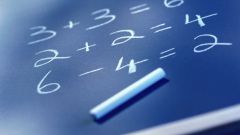Instruction
1
Start with multiplying by 1 and 10
It is always necessary to begin the study of tables with multiplying by 1 and 10. The child quickly will understand that multiplying by 1 the rst factor does not change. But if a certain number is multiplied by 10, it simply is attributed to 0.
It is always necessary to begin the study of tables with multiplying by 1 and 10. The child quickly will understand that multiplying by 1 the rst factor does not change. But if a certain number is multiplied by 10, it simply is attributed to 0.
2
Multiplying by 2
To understand how a child learn the multiplication table for 2, too easy. The student will quickly understand that when multiplying by 2 we just need to add multiply the number with him. So, 5x2 = 5+5 = 10 and 8x2 = 8+8 = 16. Similarly memorized the multiplication by 4 and 8.
To understand how a child learn the multiplication table for 2, too easy. The student will quickly understand that when multiplying by 2 we just need to add multiply the number with him. So, 5x2 = 5+5 = 10 and 8x2 = 8+8 = 16. Similarly memorized the multiplication by 4 and 8.
3
Multiplying by 5
Multiplication table 5 learns faster if the child immediately grasps that the answer is always get a number ending in 0 or 5. When you multiply five by an even number, the answer the last digit will always be 0, and when multiplied by odd – 5.
Multiplication table 5 learns faster if the child immediately grasps that the answer is always get a number ending in 0 or 5. When you multiply five by an even number, the answer the last digit will always be 0, and when multiplied by odd – 5.
4
A rule change of places of the factors
Explain to your child that from change of places of the factors, the product will not change. That is, if it will multiply 5 by 2, you get the same thing as when you multiply 2 by 5. Knowing this simple rule will significantly reduce the learning time. For example, if the student will need to decide how much will be 2x8 instead of putting the number 2 eight times, he puts two times the number 8 and get this: 2x8 = 8x2 = 8+8 = 16.
Explain to your child that from change of places of the factors, the product will not change. That is, if it will multiply 5 by 2, you get the same thing as when you multiply 2 by 5. Knowing this simple rule will significantly reduce the learning time. For example, if the student will need to decide how much will be 2x8 instead of putting the number 2 eight times, he puts two times the number 8 and get this: 2x8 = 8x2 = 8+8 = 16.
5
Key diagonal of the table
The squares of the numbers of 2x2, 3x3 and so on up to 10x10 is the key diagonal of the multiplication table. If the child will remember, how much will 2x2, 3x3 and so on, the question is, how easy it is to learn the multiplication table, for you will become even more simple. So, knowing that 8x8 = 64, the student quickly calculate how much will be 8h9. We get the following: 8h9 = 8x8 + 8 = 72.
The squares of the numbers of 2x2, 3x3 and so on up to 10x10 is the key diagonal of the multiplication table. If the child will remember, how much will 2x2, 3x3 and so on, the question is, how easy it is to learn the multiplication table, for you will become even more simple. So, knowing that 8x8 = 64, the student quickly calculate how much will be 8h9. We get the following: 8h9 = 8x8 + 8 = 72.
6
Multiplication by 9
How to quickly learn the multiplication table of 9? Remembering multiplication of numbers by 10, a child can easily learn and multiplying by 9. So, to decide how many will be 7х9, it is enough to multiply 7 by 10 and then subtract 7. Turns out: 7х9 = 7x10 – 7 = 63.
How to quickly learn the multiplication table of 9? Remembering multiplication of numbers by 10, a child can easily learn and multiplying by 9. So, to decide how many will be 7х9, it is enough to multiply 7 by 10 and then subtract 7. Turns out: 7х9 = 7x10 – 7 = 63.
Useful advice
To learn the multiplication table not enough, we still remember it. To help in memorizing, you can hang colourful multiplication tables in various places: on the fridge, on the door child (from the child), near the Desk, etc.
It is also important to consolidate the knowledge in the form of a game. Make colorful Lotto. For this we need to line the squares on sheets of paper that will fit the answers of the multiplication table, and make separate cards with examples. Child pulls a card with an example, looking for the answer on their paper and crosses out the square if the answer is correct. This continues until, until all the squares are not crossed out. And cards with wrong answers will be put off until the next game and start with them.
It is also important to consolidate the knowledge in the form of a game. Make colorful Lotto. For this we need to line the squares on sheets of paper that will fit the answers of the multiplication table, and make separate cards with examples. Child pulls a card with an example, looking for the answer on their paper and crosses out the square if the answer is correct. This continues until, until all the squares are not crossed out. And cards with wrong answers will be put off until the next game and start with them.






